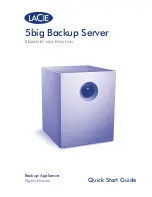
Chapter 5: Drive maintenance
28
Chapter 5: Drive maintenance
This section contains the following topics:
•
•
If a disk drive fails, replace it as soon as possible to avoid data loss.
Drive maintenance guidelines
• You can replace a single failed or failing drive without disrupting operations.
• Do not remove a drive until you are ready to replace it.
• Obtain drives of the same capacity, speed, and type before starting this procedure. For information
on supported replacement drives and the required firmware revision, contact
.
• Store drives properly. Store replacement drives in the packaging in which they were shipped. Do not stack
drives or place anything on top of a drive.
• Protect drives from electrostatic discharge. Wear an electrostatic wrist strap when handling a drive, unless it is
protected from electrostatic discharge.
• Handle drives carefully. Hold a drive only by the plastic part of the carrier or the handle. Do not drop or jolt a
drive or force a drive into a drive slot.
• Do not leave a drive slot empty. Each drive slot must contain a drive or a blank carrier. Operating the server
with an empty drive slot voids your warranty and support contract.
• Do not remove a drive from its carrier unless instructed by
Customer Support (support.hpe.com)
.
• Keep shipping material. Return a failed drive to
Customer Support (support.hpe.com)
which the replacement drive was shipped. Shipping drives in unauthorized packaging may void your warranty.
Drive replacement requires a RAID rebuild, which might take some time to complete on a server that contains
many GB or TB of data. The rebuild might proceed faster if you complete these tasks:
• Quiesce I/O or do the replacement operation at a time when I/O is minimal.
• Shut down VMs.
• Migrate VMs to an alternate host.
NOTE:
You can use the LEDs to monitor the RAID rebuild status.
For more information about how to complete the tasks, see the
HPE OmniStack Administrator Guide
.
Replace a drive
Before you begin
You have completed these tasks:
• Obtained a replacement drive of the same type, speed, and capacity of the drive you are removing.
• Read the guidelines for maintaining disk drives.










































